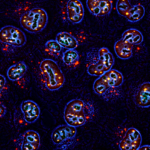Link to Pubmed [PMID] – 9636146
Proc. Natl. Acad. Sci. U.S.A. 1998 Jun;95(13):7316-21
The PML/SP100 nuclear bodies (NBs) were first described as discrete subnuclear structures containing the SP100 protein. Subsequently, they were shown to contain the PML protein which is part of the oncogenic PML-RARalpha hybrid produced by the t(15;17) chromosomal translocation characteristic of acute promyelocytic leukemia. Yet, the physiological role of these nuclear bodies remains unknown. Here, we show that SP100 binds to members of the heterochromatin protein 1 (HP1) families of non-histone chromosomal proteins. Further, we demonstrate that a naturally occurring splice variant of SP100, here called SP100-HMG, is a member of the high mobility group-1 (HMG-1) protein family and may thus possess DNA-binding potential. Both HP1 and SP100-HMG concentrate in the PML/SP100 NBs, and overexpression of SP100 leads to enhanced accumulation of endogenous HP1 in these structures. When bound to a promoter, SP100, SP100-HMG and HP1 behave as transcriptional repressors in transfected mammalian cells. These observations present molecular evidence for an association between the PML/SP100 NBs and the chromatin nuclear compartment. They support a model in which the NBs may play a role in certain aspects of chromatin dynamics.

